
The Experiment
Our past contributions to the field of gelatin-related studies include our quest for the Ultimate Jell-O shot, setting a Jell-O shot on fire, and mixing homemade ballistics gel. If anything involves Jell-O and science, we’re there. So it was with great interest that we read Graeme Cole’s groundbreaking research into the feasibility of securing Jell-O to a vertical surface by means of manually impacted cylindrical metal fasteners – otherwise known as “nailing Jell-O to a wall.”
While Mr. Cole’s attempt to nail gelatin to a wall was unsuccessful, he did conclude that further research in the area was warranted. In the interest of science, we are stepping up and have set out to replicate his results and expand upon them using a similar methodology.
Time to Make the Jell-O
The gelatin dessert that Mr.Cole used appears to have its origins in the UK and comes packaged as blocks of concentrate to be dissolved and then chilled. Our local grocery store has a British foods section, where we could buy ginger biscuits, “spotted dick” pudding and other delicacies, but they did not stock any British gelatin.
Therefore we used the familiar U.S. domestic equivalent, Jell-O brand gelatin dessert mix, which is in the form of a powder that is reconstituted with water. While we have never had the opportunity to sample the UK equivalent of Jell-O, we will assume that both yield a final product similar in consistency and deliciousness, albeit with variations in color palette and flavor selection that should not affect the results one way or another.
We attempted to improve the outcome of this experiment by using three basic tactics: increasing the strength of the Jell-O by altering the recipe, enhancing the Jell-O by embedding reinforcing materials, and attempting to decrease the stress on the Jell-O around the nails. Unless otherwise specified, all Jell-O was prepared according the the package directions, which called for 6 oz. of powdered mix to be dissolved in 2 cups hot water, to which another 2 cups cold water was added.
Let’s Give It a Go
Before testing these alternatives, our first task was to simply retry the original experiment, attempting to nail to a board a slab of Jell-O made according to package directions. We unmolded the gelatin directly onto the board and began nailing it in place, but the violence of the hammering was enough to fracture the Jell-O in the center before we had finished.
Standard Jell-O Recipe
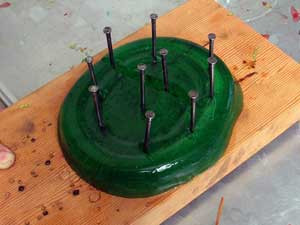
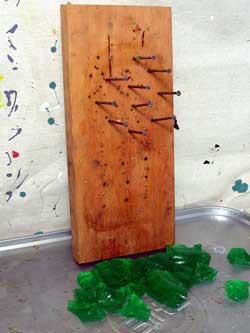
Once vertical, the Jell-O immediately began to slide off the nails, and within 3 seconds had slid off the nails completely. As you can see, our results were virtually identical to Mr. Cole’s, and support that part of his research.
Deep Jell-O Mold


We also tried using a smaller but deeper sample of Jell-O, similar to what was used in the second part of Mr. Cole’s experiment. Our thinking was that maybe if the weight was supported along more of the length of the nail, the Jell-O might hold longer. This was marginally true. We were at least able to get the board vertical for a second before the Jell-O fell to bits.
Trying to Nail It Down
Next we tried the samples that had holes or tubes for the nails molded into them.
Sample: Regular Jell-O with holes molded into it
One of Mr. Cole’s readers pointed out that the nails were causing tears in the Jell-O, and better results might be achieved by molding holes into the gelatin. We tested this by preparing a sample to set with 5 Sharpie pens secured standing upright in it.
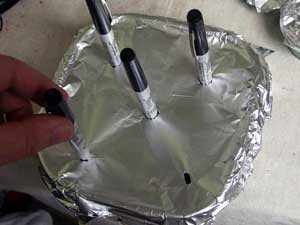
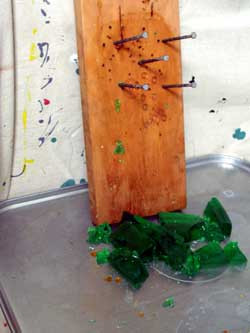
Jell-O with Holes Molded Into It
Results: We weren’t terribly optimistic about the Jell-O with the holes molded into it. But we were surprised that it hung in there for as long as it did. It didn’t immediately slide off the nails and down the board as the regular Jell-O had, but lingered for a second or two longer before breaking up and falling down.
Sample: Regular Jell-O with plastic straws
Our other idea was to create “grommets” in the Jell-O by using sections of plastic drinking straws. We made two samples with 5 and 9 straws respectively, poking the straws through holes in duct tape over the top of the mold container to hold them in place.
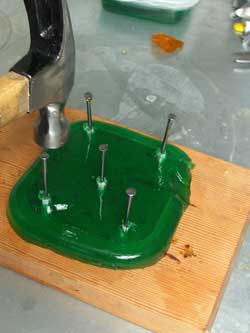
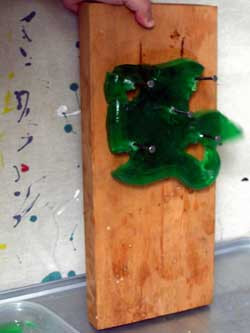
5 Straw Supports
Results:
We trimmed the straws before inverting the Jell-O then inserted the nails through them and attempted to hammer the nails without disturbing the surrounding Jell-O. This was more difficult than it sounds.
7 Straw Supports
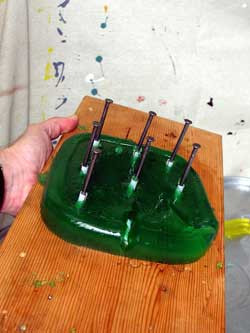
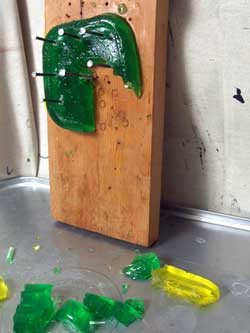
The slab with 5 straws embedded in it lasted only a second or two more than the plain Jell-O before falling apart. A second prepared slab was supposed to have 9 straws in it, but due to the difficulty of removing the duct tape supports from around the straws, it ended up with only 7. In retrospect we probably should have just put plain nails in their place. Nevertheless, there was still a slight improvement. Within 30 seconds, about 50% of the Jell-O fell off (the portion with fewer nails in it) and the remainder fell off over the course of the next minute. Two small pieces remained, but they were merely balanced atop nails, rather than being nailed through, so we didn’t count them.
Made of Stronger Stuff
These samples all used alternative Jell-O recipes.
Sample: Jell-O Jigglers Success!
The Jell-O “Jigglers” recipe is also featured on the product package along with the regular directions. This recipe calls for doubling the amount of Jell-O powder and cutting the water by almost half (12 oz. Jell-O powder and 2 1/2 cups water).

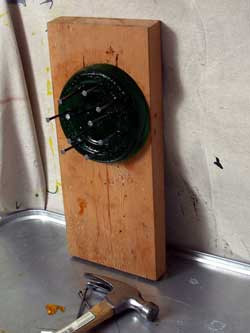
Jell-O Jigglers Recipe
Results: The result is a very firm, concentrated form of Jell-O, which is probably closer to what comes out of the package in the UK. When we nailed this to the board and propped it up, it seemed it would stay put indefinitely. There were small fractures around the nails, but the gelatin was holding and the tears showed no signs of enlarging. The Jell-O Jiggler sample stayed up until we took it down, which was over 15 minutes.
Sample: Lemon Jell-O with one packet of Knox gelatin powder added
We also made samples by fortifying the original recipe with .25 oz. (one packet) and .5 oz. (two packets) of Knox unflavored gelatin.
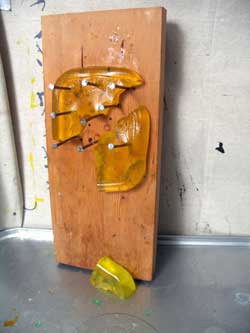
One Packet of Knox Gelatin
Results: This was much firmer than regular Jell-O but maybe not as firm as the Jigglers. Once vertical, the sample looked good for about 6 minutes, and then a large diagonal crack developed. Five minutes after that, 50% of the Jell-O had fallen, but the other half didn’t seem to be going anywhere. Eventually we took it down and moved on.
Sample: Watermelon Jell-O with two packets of Knox gelatin powder added Success!
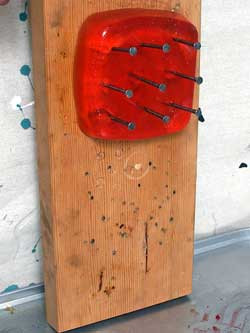
Two Packets of Knox Gelatin
Results: This sample was approximately the same consistency and durability as the Jell-O Jigglers, and remained affixed to the board until removed. Although adding two packets of unflavored gelatin substantially reinforced the Jell-O, we would not recommend this recipe for consumption. The Jigglers taste much better.
Sample: Ballistic gelatin Success!
In his original work, Mr. Cole commented that technically the problem of “nailing Jell-O to a wall” is basically intractable, since one cannot hold Jell-O up to a vertical surface in order to nail it without having it fall apart. So we mixed up a batch of our ballistic gel. It’s a super concentrated form of gelatin with the consistency of rubber that’s used to test the penetrating power of firearms. We made our homemade version using 4 oz. unflavored Knox gelatin powder with 2 cups water, using the process detailed here.
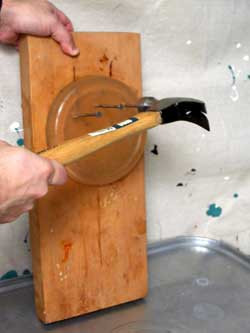
Nailing Ballistics Gelatin to the Wall
Results: We had no difficulty handling the sample and holding it up to the vertical board to be nailed. However, while you can nail ballistic gel to a wall, you have to work fast and use enough nails, otherwise it will succumb to the stress of hanging on one or two points. And yes, we know, this is cheating. We just did it because we could.
Culinary Adventures
Finally, we prepared several samples using a range of ingredients to lend structural support, most of them at least theoretically edible.
Sample: Lemon Jell-O with Red Vines
We wove lengths of Red Vines licorice into a lattice, over which the Jell-O mixture was poured. We thought this would look cooler than it did, but the licorice was kind of hard to work with.
Results:
We were a little apprehensive even before unmolding this sample, as an unusual amount of liquid had accumulated on the top and around the edges. Our guess is that this was a byproduct of some reaction between the Jell-O and the Red Vines, which appeared degraded and fragmented.
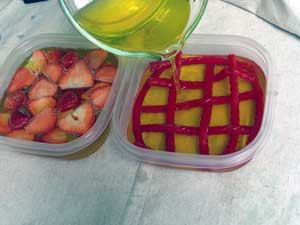

Red Vine Licorice
The Jell-O held its shape, however, and we forged on. The licorice didn’t do much to help support the gelatin; in fact, we think the partially dissolved licorice may have weakened it. The whole mess disintegrated rapidly when the board was tilted upright, till 20 seconds later nothing remained but a fragment of licorice balanced on a nail. However, while this combination of lemon Jell-O and Red Vines did not result in the increased structural integrity we hoped for, it actually tasted pretty good.
Sample: Cherry Jell-O with banana slices
Slices of this popular Jell-O add-in were layered in the sample before chilling.
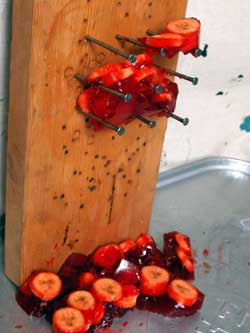
Bananas
Results: The banana sample looked good, with slices well-distributed depth wise throughout the cherry Jell-O. As we nailed this sample to the board, we placed the nails without regard as to whether they were going through pieces of fruit or not. The Jell-O held on fairly well as the board was raised up and it seemed rather secure. It looked promising. However, when it reached its full vertical position, the slab buckled and fell forward at the top. It hung in there for about ten seconds and then fell apart.
Sample: Lemon Jell-O with strawberry slices
Strawberries were sliced to about ¼ inch thickness and layered in the Jell-O before chilling.
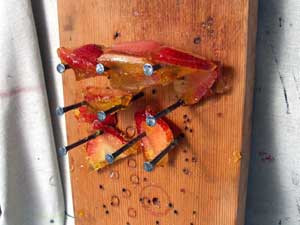
Strawberry Slices
Results: In the strawberry sample, the fruit slices were mainly concentrated in a layer on the bottom (i.e., on the top when unmolded). Strawberries were out of season at the time this experiment was performed, so they were more solid and rigid than ripened fruit would be. The results were similar to the Jell-O with bananas. The fruit didn’t do a whole lot to keep the Jell-O together, and within a few seconds all that was left were a few strawberries nailed to a board.
Sample: Cherry Jell-O with spring roll wrappers
We took spring roll wrappers, which are made from tapioca, softened them in water and used one to line a Jell-O mold, while another was suspended in the Jell-O mix.

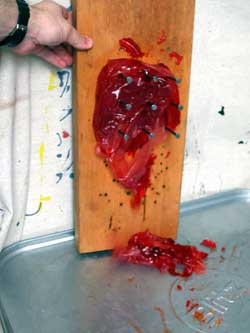
Spring Roll Wrappers
Results: Here also, it appeared that there was some reaction between the gelatin and the additive. The Jell-O was firm in the middle but was losing its shape around the edges when unmolded. After being nailed into place and positioned vertically, the Jell-O broke up and fell off, leaving soggy spring roll wrappers draped over the nails.
Sample: Orange Jell-O with ramen noodles
The noodles were uncooked but were soaked briefly in warm water, transferred intact to the molding container, and then covered with Jell-O solution. The soaking step was probably unnecessary as the noodles would have absorbed water from the Jell-O. We discarded the ramen flavor packet.
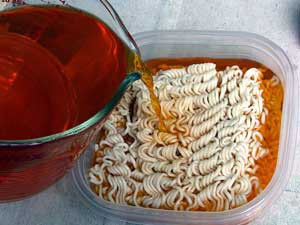

Ramen Noodles
Results: The noodles permeated the gelatin sample completely – in fact, the sample may have been as much or more noodles than gelatin by volume. When it was hammered into place and raised vertically, the unsupported bottom edge of the square immediately fell off, leaving a fringe of noodles dangling. However, the remainder of the Jell-O stabilized and stayed put on the nails quite securely, and was impervious as the board was moved, picked up, and gently shaken. After more than 10 minutes, the Jell-O was still not going anywhere, and we had to get on with the experiment, but had we left it in place we imagine it would have stayed put until the Jell-O began to dissolve. The orange Jell-O/ramen combination was palatable, if a bit on the bland side. Next time we might add the flavor packet.
Sample: Orange Jell-O with plastic mesh Success!
The final sample in this category contains an inedible ingredient - a plastic mesh produce packaging bag that originally held cherry tomatoes. We cut the mesh to fit the molding container, and embedded it in the Jell-O. In order to get the material properly suspended in the gelatin, we waited until it was partially gelled before adding it.
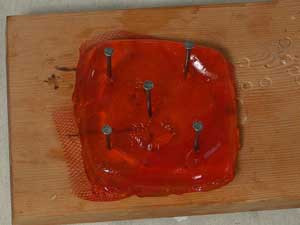
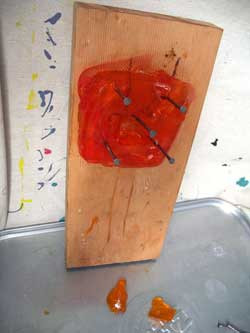
Plastic Mesh
Results: Of all the samples made with regular Jell-O, this was the only one that remained virtually intact when held in a vertical position. We were actually surprised at how well it held together. We expected some of the Jell-O to slip off the plastic mesh, but the internal matrix of netting helped the Jell-O keep its shape and supported its weight on the nails, as well as the portion of the sample below the nails. Even shaking the board vigorously did not dislodge the Jell-O. Although the perimeter remained intact, eventually a couple of blobs of Jell-O did fall off of the center. The remainder stayed affixed for more than 15 minutes. All in all we, we would say this was the most successful sample in this category, and it could probably withstand an earthquake of 4.0 or greater.
Conclusions
In repeating Mr. Cole’s initial experiment, we duplicated his results. This substantiates his claim that scientific evidence supports the adage that “nailing Jell-O to a wall” is representative of an impossible or near-impossible task.
Our further investigation into this area leads us to state the following: Jell-O can be effectively nailed to a wall if you increase its density by reducing the proportion of water to gelatin in the recipe, or fortify it by adding more gelatin powder. Molding holes into the Jell-O or attempting to reinforce the holes was not substantially effective in increasing its ability to withstand stress. Apparently you can also nail Jell-O to a wall if you embed plastic mesh in it, or ramen noodles. Sliced fruit may increase Jell-O’s nutritional value, but makes only a minor contribution to its structural integrity when embedded. The spring roll wrappers were a waste. Licorice twists appeared to cause an adverse chemical reaction in the Jell-O. Nevertheless, it is our subjective finding that Jell-O + Red Vines = crazy delicious.
We feel we have covered a lot of ground in investigating possible solutions to this problem. Future experiments might involve different Jell-O additives, the incorporation of external structural support around the Jell-O, or the use of alternative means of fastening the Jell-O to the wall, besides nails.
We believe the most promising direction for research would involve attempting to nail Jell-O to a wall in zero-gravity conditions. We lack the resources and funds to attempt such a project, but we encourage its undertaking by any persons or organizations who do.
Other experiments:
What is the Ultimate Jello-Shot?
How to Light a Jell-O Shot on Fire
How Many Condoms Can You Wear at Once?
Does Viagra Keep Flowers from Wilting?
How To Keep Beer Cold
The Cheney Shotgun Experiment